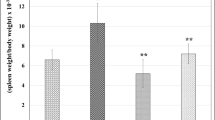Abstract
Orally administered meso-2,3-dimercaptosuccinic acid (DMSA) is an effective antagonist for acute oral cadmium chloride (1 mmol/kg) intoxication in mice when administered up to 8 h after cadmium ingestion. Administration of sodium N-benzyl-N-dithiocarboxy-d-glucamine (NaB) i.p. along with DMSA p.o. resulted in kidney and liver cadmium levels only marginally smaller than those obtained with DMSA alone. Both chelation treatment regimens permitted survival of 80% or more of the animals, in comparison to a survival rate of 40–50% in untreated animals. Intraperitoneally administered NaB by itself is a very effective antagonist for cadmium chloride administered intraperitoneally in either acute or chronic cadmium intoxication. A dose-response study was made of the mobilization of cadmium from the liver and kidney of cadmium-loaded mice by NaB; this showed that NaB is one of the most effective cadmium mobilizing agents developed to date. We have also confirmed the earlier report of Kojima and his co-workers of the ability of NaB to remove cadmium from animals which have been treated with cadmium over an extended period of time. NaB causes a very large increase in the biliary excretion of cadmium. Nuclear magnetic resonance (NMR) spectra of 113Cd in bile from treated animals and model solutions indicates that such cadmium is undergoing rapid ligand exchange.
Similar content being viewed by others
References
Andersen O (1984) Chelation of cadmium, Environ Health Perspect 54: 249–266
Andersen O, Nielsen JB, Svendsen P (1985) Oral cadmium toxicology. Acta Pharmacol Toxicol 59: Suppl. VII, 44–47
Bakka A, Aaseth J (1979) Cadmium excretion in mice given dimercaptopropanesulphonate and some other complexing thiols. Arh Hig Rada Toksikal 30: suppl, 183–189
Basinger MA, Jones MM, Holscher MA, Vaughn WK (1988) Antagonists for acute oral cadmium chloride intoxication. J Toxicol Environ Health 23: 77–89
Birgersson B, Carter RE, Drakenberg T (1977) A 113Cd NMR study of cadmium-glutathione complexes. J Magnet Reson 28: 299–302
Bulman RA, Griffin RJ (1981) Plutonium decorporation with a partially lipophilic chelating agent. Naturwissenschaften 67: 483–484
Bulman RA, Andersen O, Nielsen JB (1985) Effects of macromolecular chelators on G. I. Cd absorption. Acta Pharmacol Toxicol 59: Suppl. VII, 524–527
Catsch A (1968) Dekorporierung radioaktiver und stabiler metallionen. Karl Thiemig, Munich, pp 93–97
Catsch A, Tocchini-Valentini GP (1961) Der Einfluss einiger polyaminocarbonsäuren auf die Verteilung von Thorium234 im Organismus der Ratte. Strahlentherapie 116: 426–434
Cikrt M, Basinger MA, Jones SG, Jones MM (1986) Structural effects in the dithiocarbamate-enhanced biliary excretion of cadmium. J Toxicol Environ Health 17: 429–439
Foulkes EC (ed) (1986) Cadmium. Handbook of Experimental Pharmacology, Vol. 80. Springer-Verlag, Berlin
Friberg L (1956) Edathamil calcium disodium in cadmium poisoning. Arch Ind Health 13: 18–23
Friberg L, Elinder C-G, Kjellstrom T, Nordberg GF (eds) (1985–1986) Cadmium and health: A toxicological and epidemiological appraisal. CRC Press, Inc, Boca Raton, Florida, USA (two volumes)
Gale GR, Atkins LM, Walker EM (1981) Diethyldithiocarbamate in treatment of acute cadmium posioning. Ann Clin Lab Sci 11: 476–483
Gale GR, Atkins LM, Walker EM Jr, Smith AB (1983) Comparative effects of diethyldithiocarbamate, dimercaptosuccinate and diethylenetriaminepenta-acetate on organ distribution and excretion of cadmium. Ann Clin Lab Sci 13: 33–44
Gale GR, Shinobu LA, Jones MM, Atkins LM, Smith AB (1984) Effects of sodium N-methyl-N-dithiocarboxyglucamine on cadmium distribution and excretion. Life Sci 35: 2571–2578
Gale GR, Smith AB, Atkins LM, Jones MM (1985) Effects of diethyldithiocarbamate and N-methyl-N-dithiocarboxyglucamine on murine hepatic cadmium metallothionein in vitro. Res Commun Chem Pathol Pharmacol 49: 423–434
Jones SG, Jones MM (1984) Structure-activity relationships among dithiocarbamate antidotes for acute cadmium chloride intoxication. Environ Health Perspect 54: 285–290
Jones SG, Jones MM, Basinger MA, Burka LT, Shinobu LA (1983) Polarity and antidotal efficacy of dithiocarbamates in acute cadmium intoxication. Res Commun Chem Pathol Pharmacol 40: 155–164
Kennedy A (1968) The effect of L-cysteine on the toxicity of cadmium. Br J Exp Pathol 49: 360–364
Kojima S, Kaminaka K, Kiyozumi M, Honda T (1986a) Comparative effects of three chelating agents on distribution and excretion of cadmium in rats. Toxicol Appl Pharmacol 83: 516–524
Kojima S, Kaminaka K, Kiyozumi M, Honda T (1986b) Effects of chelating agents on biliary and urinary excretion and tissue distribution of cadmium in rats. Toxicol Lett 34: 41–46
Li T-Y, Kracker AJ, Shaw CF III, Petering DH (1980) Ligand substitution reactions of metallothioneins with EDTA and apo-carbonic anhydrase. Proc Natl Acad Sci USA 77: 6334–6338
Lyle WH, Green JN, Gore V, Vidler J (1968) Enhancement of cadmium nephrotoxicity by penicillamine in the rat. Postgrad Med J 44: Suppl. October, 18–21
McCleverty JA, Gill S, Zowalski RSZ, Bailey NA, Adams H, Lumbard KW, Murphy MA (1982) Aspects of the inorganic chemistry of rubber vulcanisation. Part 3. Anionic cadmium complexes derived from dialkyldithiocarbamates, 2-mercaptobenzothiazole and its derivatives, and dialkyl dithiophosphates, and the crystal and molecular structure of [NBu4 n] [CD(S2CNEt2)3], [NEt4 [Cd(C7H4NS2)3] and [NMe4] [Cd[S2P(OPri)2)3]. J Chem Soc Dalton, 493–503
Murakami M, Webb M (1981) A morphological and biochemical study of the effects of L-cysteine on the renal uptake and nephrotoxicity of cadmium. Br J Exp Pathol 62: 115–130
Nielsen JB, Andersen O, Svendsen P (1985) Effect of DDC (sodium diethyldithiocarbamate) on acute oral Cd toxicity. Acta Pharmacol toxicol 59: Suppl. VII, 490–493
Nordberg GF (1984) Chelating agents and cadmium toxicity: problems and prospects. Environ Health Perspect 54: 213–218
Planas-Bohne F, Lehmann M (1983) Influence of chelating agents on the distribution and excretion of cadmium in rats. Toxicol Appl Pharmacol 67: 408–416
Shaikh ZA, Lucis OJ (1972) Biological differences in cadmium and zinc turnover. Arch Environ Health 24: 410–418
Shinobu LA, Jones SG, Jones MM (1983) Mobilization of aged cadmium deposits by dithiocarbamates. Arch Toxicol 54: 235–242
Shinobu LA, Jones SG, Jones MM (1984) Sodium N-methyl-d-glucamine dithiocarbamate and cadmium intoxication. Acta Pharmacol Toxicol 54: 189–194
Webb W (ed) (1979) The chemistry, biochemistry and biology of cadmium. Elsevier/North Holland Biomédical Press, Amsterdam
Author information
Authors and Affiliations
Rights and permissions
About this article
Cite this article
Jones, M.M., Basinger, M.A., Topping, R.J. et al. Meso-2,3-dimercaptosuccinic acid and sodium N-benzyl-N-dithiocarboxy-D-glucamine as antagonists for cadmium intoxication. Arch Toxicol 62, 29–36 (1988). https://doi.org/10.1007/BF00316253
Received:
Accepted:
Issue Date:
DOI: https://doi.org/10.1007/BF00316253




